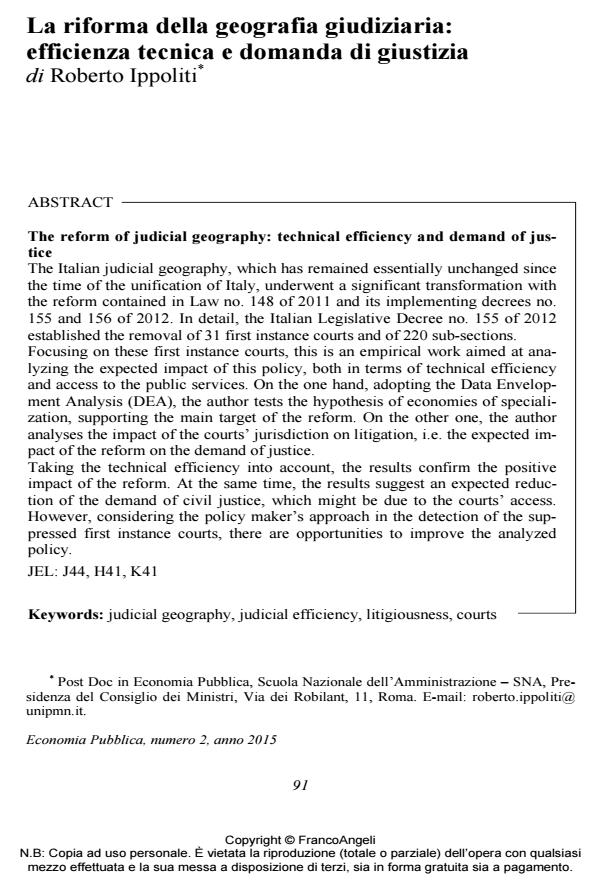La riforma della geografia giudiziaria: efficienza tecnica e domanda di giustizia
Titolo Rivista ECONOMIA PUBBLICA
Autori/Curatori Roberto Ippoliti
Anno di pubblicazione 2016 Fascicolo 2015/2
Lingua Italiano Numero pagine 34 P. 91-124 Dimensione file 345 KB
DOI 10.3280/EP2015-002003
Il DOI è il codice a barre della proprietà intellettuale: per saperne di più
clicca qui
Qui sotto puoi vedere in anteprima la prima pagina di questo articolo.
Se questo articolo ti interessa, lo puoi acquistare (e scaricare in formato pdf) seguendo le facili indicazioni per acquistare il download credit. Acquista Download Credits per scaricare questo Articolo in formato PDF

FrancoAngeli è membro della Publishers International Linking Association, Inc (PILA)associazione indipendente e non profit per facilitare (attraverso i servizi tecnologici implementati da CrossRef.org) l’accesso degli studiosi ai contenuti digitali nelle pubblicazioni professionali e scientifiche
The Italian judicial geography, which has remained essentially unchanged since the time of the unification of Italy, underwent a significant transformation with the reform contained in Law no. 148 of 2011 and its implementing decrees no. 155 and 156 of 2012. In detail, the Italian Legislative Decree no. 155 of 2012 established the removal of 31 first instance courts and of 220 sub-sections. Focusing on these first instance courts, this is an empirical work aimed at analyzing the expected impact of this policy, both in terms of technical efficiency and access to the public services. On the one hand, adopting the Data Envelopment Analysis (DEA), the author tests the hypothesis of economies of specialization, supporting the main target of the reform. On the other one, the author analyses the impact of the courts’ jurisdiction on litigation, i.e. the expected impact of the reform on the demand of justice. Taking the technical efficiency into account, the results confirm the positive impact of the reform. At the same time, the results suggest an expected reduction of the demand of civil justice, which might be due to the courts’ access. However, considering the policy maker’s approach in the detection of the suppressed first instance courts, there are opportunities to improve the analyzed policy.
Parole chiave:Judicial geography, judicial efficiency, litigiousness, courts
Jel codes:J44, H41, K41
- Factors affecting judicial system efficiency: a systematic mapping review with a focus on Italy Monica Giancotti, Giorgia Rotundo, Marianna Mauro, in International Journal of Productivity and Performance Management /2024 pp.2951
DOI: 10.1108/IJPPM-05-2023-0215 - Global Encyclopedia of Public Administration, Public Policy, and Governance Greta Falavigna, Roberto Ippoliti, pp.6742 (ISBN:978-3-030-66251-6)
- L’esperienza Uni4Justice e le prospettive future Le ricerche del team di Ca’ Foscari Michele Zanette, Alessandro Grassi, (ISBN:978-88-6969-766-1)
- Global Encyclopedia of Public Administration, Public Policy, and Governance Greta Falavigna, Roberto Ippoliti, pp.1 (ISBN:978-3-319-31816-5)
- Data envelopment analysis to investigate the Italian legal system and its reform Greta Falavigna, Roberto Ippoliti, in Journal of Public Affairs e2877/2023
DOI: 10.1002/pa.2877
Roberto Ippoliti, La riforma della geografia giudiziaria: efficienza tecnica e domanda di giustizia in "ECONOMIA PUBBLICA " 2/2015, pp 91-124, DOI: 10.3280/EP2015-002003